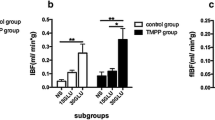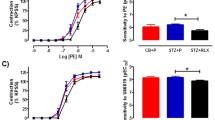Abstract
Aims: Pancreatic microcirculation plays a pivotal role in the physiological function and survival of β-cells. Ang(1–7) is a novel component of the renin angiotensin system (RAS) that has beneficial effects on microcirculation. In the present study, we investigated the effects of systemic Ang(1–7) administration (with or without its receptor Mas antagonist A-779) on pancreatic microcirculation and β-cell function. Methods: These effects were studied in vivo using a rat model of Type 2 diabetes (T2DM). Pancreatic microcirculation and islet microvessel density were measured; and β-cell function, insulin content, and the apoptosis of islet cells were assessed, respectively. Additionally, we evaluated endothelial nitric oxide synthase (eNOS) expression and nitric oxide (NO) concentration in islets. Results: After Ang(1–7) intervention, pancreatic microcirculation and intra-islet microvessel density were significantly improved (p<0.05), and more importantly, first-phase insulin secretion of β-cells as well as relative insulin content in islets were increased, and the amount of apoptotic islet cells was decreased (p<0.05). And eNOS expression and NO release were up-regulated in pancreatic islets by Ang(1–7) administration (p<0.05). These positive effects of Ang(1–7) were prevented by the addition of A-779 (p<0.05). Conclusions: Our findings suggest that systemic Ang(1–7) treatment could attenuate β-cell dysfunction and ameliorate islet cell apoptosis in T2DM rats by improving pancreatic microcirculation, perhaps through the mechanism of endothelial vasodilation.
Similar content being viewed by others
References
Nikolova G, Jabs N, Konstantinova I, et al. The vascular basement membrane: a niche for insulin gene expression and Beta cell proliferation. DevCell 2006, 10: 397–405.
Zanone MM, Favaro E, Camussi G. From endothelial to Beta cells: insights into pancreatic islet microendothelium. Curr Diabetes Rev 2008, 4: 1–9.
Li X, Zhang L, Meshinchi S, et al. Islet microvasculature in islet hyperplasia and failure in a model of type 2 diabetes. Diabetes 2006, 55: 2965–73.
Leung PS. Mechanisms of protective effects induced by blockade of the renin-angiotensin system: novel role of the pancreatic islet angiotensin-generating system in Type 2 diabetes. Diabet Med 2007, 24: 110–6.
Shao J, Iwashita N, Ikeda F, et al. Beneficial effects of candesartan, an angiotensin II type 1 receptor blocker, on beta-cell function and morphology in db/db mice. Biochem Biophys Res Commun 2006, 344: 1224–33.
Younis F, Stern N, Limor R, Oron Y, Zangen S, Rosenthal T. Telmisartan ameliorates hyperglycemia and metabolic profile in nonobese Cohen-Rosenthal diabetic hypertensive rats via peroxisome proliferator activator receptor-gamma activation. Metabolism 59: 1200–9.
Li X, Yuan L, Xu G, et al. Effect of renin angiotensin system blockade on the islet microvessel density of diabetic rats and its relationship with islet function. J Huazhong Univ Sci Technolog Med Sci 2009, 29: 684–8.
Yuan L, Li X, Xu GL, Qi CJ. Effects of renin-angiotensin system blockade on islet function in diabetic rats. J Endocrinol Invest 33: 13–9.
Yuan L, Li X, Li J, Li HL, Cheng SS. Effects of renin-angiotensin system blockade on the islet morphology and function in rats with long-term high-fat diet. Acta Diabetol 2013. 50: 479–88.
Tikellis C, Cooper ME, Thomas MC. Role of the renin-angiotensin system in the endocrine pancreas: Implications for the development of diabetes. Int J Biochem Cell Biol 2006, 38: 737–51.
Zhang Y, Lu J, Shi J, et al. Central administration of angiotensin-(1–7) stimulates nitric oxide release and upregulates the endothelial nitric oxide synthase expression following focal cerebral ischemia/reperfusion in rats. Neuropeptides 2008, 42: 593–600.
Santos RA, Ferreira AJ, Simoes ESAC. Recent advances in the angiotensin-converting enzyme 2-angiotensin(1–7)-Mas axis. Exp Physiol 2008, 93: 519–27.
Peiro C, Vallejo S, Gembardt F, et al. Endothelial dysfunction through genetic deletion or inhibition of the G protein-coupled receptor Mas: a new target to improve endothelial function. J Hypertens 2007, 25: 2421–5.
Ferreira AJ, Santos RA. Cardiovascular actions of angiotensin-(1–7). Braz J Med Biol Res 2005, 38: 499–507.
Reed MJ, Meszaros K, Entes LJ, et al. A new rat model of type 2 diabetes: the fat-fed, streptozotocin-treated rat. Metabolism 2000, 49: 1390–4.
Giani JF, Mayer MA, Munoz MC, et al. Chronic infusion of angiotensin-(1–7) improves insulin resistance and hypertension induced by a high-fructose diet in rats. Am J Physiol Endocrinol Metab 2009, 296: E262–71.
Shao Y, He M, Zhou L, Yao T, Huang Y, Lu LM. Chronic angiotensin (1–7) injection accelerates STZ-induced diabetic renal injury. Acta Pharmacol Sin 2008, 29: 829–37.
Benter IF, Yousif MH, Cojocel C, Al-Maghrebi M, Diz DI. Angiotensin-(1–7) prevents diabetes-induced cardiovascular dysfunction. Am J Physiol Heart Circ Physiol 2007, 292: H666–72.
Walter B, Bauer R, Gaser E, Zwiener U. Validation of the multiple colored microsphere technique for regional blood flow measurements in newborn piglets. Basic Res Cardiol 1997, 92: 191–200.
Hakkinen JP, Miller MW, Smith AH, Knight DR. Measurement of organ blood flow with coloured microspheres in the rat. Cardiovasc Res 1995, 29: 74–9.
Carlsson PO, Berne C, Jansson L. Angiotensin II and the endocrine pancreas: effects on islet blood flow and insulin secretion in rats. Diabetologia 1998, 41: 127–33.
Tikellis C, Wookey PJ, Candido R, Andrikopoulos S, Thomas MC, Cooper ME. Improved islet morphology after blockade of the reninangiotensin system in the ZDF rat. Diabetes 2004, 53: 989–97.
Hellman B, Jansson L, Dansk H, Grapengiesser E. Effects of external ATP on Ca(2+) signalling in endothelial cells isolated from mouse islets. Endocrine 2007, 32: 33–40.
Yoshitomi H, Zaret KS. Endothelial cell interactions initiate dorsal pancreas development by selectively inducing the transcription factor Ptf1a. Development 2004, 131: 807–17.
Johansson M, Mattsson G, Andersson A, Jansson L, Carlsson PO. Islet endothelial cells and pancreatic beta-cell proliferation: studies in vitro and during pregnancy in adult rats. Endocrinology 2006, 147: 2315–24.
Johansson A, Lau J, Sandberg M, Borg LA, Magnusson PU, Carlsson PO. Endothelial cell signalling supports pancreatic beta cell function in the rat. Diabetologia 2009, 52: 2385–94.
Niu MJ, Yang JK, Lin SS, Ji XJ, Guo LM. Loss of angiotensin-converting enzyme 2 leads to impaired glucose homeostasis in mice. Endocrine 2008, 34: 56–61.
Bindom SM, Hans CP, Xia H, Boulares AH, Lazartigues E. Angiotensin I-converting enzyme type 2 (ACE2) gene therapy improves glycemic control in diabetic mice. Diabetes 2010, 59: 2540–8.
Bindom SM, Lazartigues E. The sweeter side of ACE2: Physiological evidence for a role in diabetes. Mol Cell Endocrinol 2009, 302: 193–202.
Author information
Authors and Affiliations
Corresponding author
Additional information
L. Yuan and Y. Li are co-first authors.
Rights and permissions
About this article
Cite this article
Yuan, L., Li, Y., Li, G. et al. Ang(1–7) treatment attenuates β-cell dysfunction by improving pancreatic microcirculation in a rat model of Type 2 diabetes. J Endocrinol Invest 36, 931–937 (2013). https://doi.org/10.3275/8951
Accepted:
Published:
Issue Date:
DOI: https://doi.org/10.3275/8951




